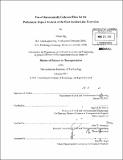| dc.contributor.advisor | Nigel H.M. Wilson and John P. Attanucci. | en_US |
| dc.contributor.author | Ng, Albert (Albert Y.) | en_US |
| dc.contributor.other | Massachusetts Institute of Technology. Dept. of Civil and Environmental Engineering. | en_US |
| dc.coverage.spatial | e-uk-en | en_US |
| dc.date.accessioned | 2011-06-20T15:53:54Z | |
| dc.date.available | 2011-06-20T15:53:54Z | |
| dc.date.copyright | 2011 | en_US |
| dc.date.issued | 2011 | en_US |
| dc.identifier.uri | http://hdl.handle.net/1721.1/64575 | |
| dc.description | Thesis (S.M. in Transportation)--Massachusetts Institute of Technology, Dept. of Civil and Environmental Engineering, 2011. | en_US |
| dc.description | Cataloged from PDF version of thesis. | en_US |
| dc.description | Includes bibliographical references (p. 151-154). | en_US |
| dc.description.abstract | Data from public transport automated data collection (ADC) systems are now widely used in academic research and are beginning to be used for planning purposes. ADC systems provide ubiquitous and inexpensive, if limited, data streams for planning purposes. Since ADC data systems have been around for some time and are deployed by many large public transport agencies, the resulting data can be used for before and after impact analyses of changes in the transportation system. This research explores the use of automatically collected data to understand the impacts of a major public transport infrastructure investment on a complex existing network. The research presents the methods, using automatically collected data, to determine the impacts on multiple modes of transportation and the preliminary results of the impact of the introduction of the East London Line Extension. The East London Line is still in the early stages of growth and first and second order impacts continue to develop. The line is carrying an average of approximately 70,000 passengers per day and ridership continues to increase monthly. The East London Line is an important public transport crossing of the Thames River and a crucial role as a distributer to and from intersecting rail lines. It was estimated that between 28 to 32 percent of the daily weekday passenger journeys are new journeys to the public transport system. There is a change in ridership on many bus routes that run through the area served by the East London line. A more detailed analysis on four bus routes that run parallel to the East London Line and two bus routes that act as feeder routes show mixed results by route, direction, and time period. The mixed results lead us to believe that based on this preliminary impact analysis, the East London line can have a positive and negative impact on bus ridership but the impacts are most likely route, route segment, time of day, and direction specific. Analysis of disaggregate data showed that journey frequency of East London Line patrons increased at a higher rate than for the control panel. It is clear that ADC system data provides a cost effective means to capture a breath and depth of data suitable for impact analyses. | en_US |
| dc.description.statementofresponsibility | by Albert Ng. | en_US |
| dc.format.extent | 154 p. | en_US |
| dc.language.iso | eng | en_US |
| dc.publisher | Massachusetts Institute of Technology | en_US |
| dc.rights | M.I.T. theses are protected by
copyright. They may be viewed from this source for any purpose, but
reproduction or distribution in any format is prohibited without written
permission. See provided URL for inquiries about permission. | en_US |
| dc.rights.uri | http://dspace.mit.edu/handle/1721.1/7582 | en_US |
| dc.subject | Civil and Environmental Engineering. | en_US |
| dc.title | Use of automatically collected data for the preliminary impact analysis of the East London Line extension | en_US |
| dc.type | Thesis | en_US |
| dc.description.degree | S.M.in Transportation | en_US |
| dc.contributor.department | Massachusetts Institute of Technology. Department of Civil and Environmental Engineering | |
| dc.identifier.oclc | 727033329 | en_US |
